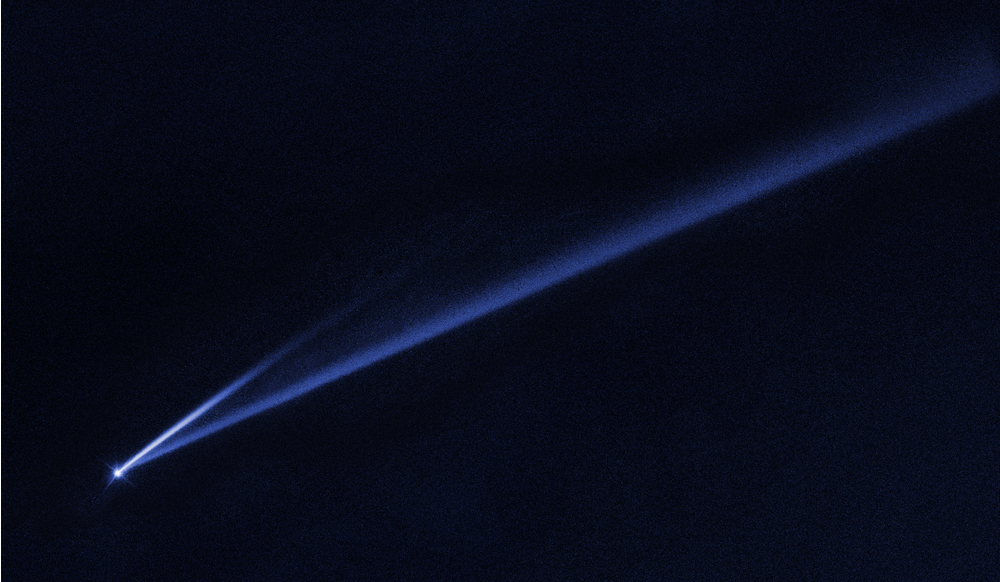
The Hubble Space Telescope—jointly operated by NASA and the European Space Agency—has captured spectacular images of a rare event: an asteroid which is spinning so fast that it is self-destructing.
The 2.5 mile-wide asteroid known as 6478 Gault was first discovered in 1988 and has been on the scopes of astronomers since. However, the new images are the first piece of evidence to indicate that the asteroid—which is located 214 million miles from the Sun—is falling apart.
This evidence comes in the form of two narrow, comet-like tails of debris that can be seen clearly in the Hubble pictures, suggesting that there were two separate events when material was being ejected from the object.
The sharp images enabled the researchers to infer that this ejection of material occurred in short episodes, which could have lasted anywhere from a few hours to a couple of days.
"Gault is a main-belt asteroid, discovered in 1988, and a fairly low-profile one among the nearly one million asteroids we know of," Olivier Hainaut, an astronomer from the European Southern Observatory, told Newsweek.
"That is, until January, when it was noticed that it had a comet-like tail. As normal rocky asteroids don't have tails, this caught our—and many other astronomers'—attention. After a few weeks, it developed a second tail, also extremely narrow one like the first one."
Researchers say that 6478 Gault is only the second asteroid that has been observed disintegrating as a result of a process known as the Yarkovsky-O'Keefe-Radzievskii-Paddack, or YORP, effect. This phenomenon occurs when sunlight heats an asteroid and causes it to spin faster and faster to the point at which the object becomes unstable.
"At any one time, radiation from the Sun hits half of the surface of the asteroid," Hainaut said. "Part of that radiation is reflected, and part is absorbed, warming up the surface, which in turns re-emits thermal radiation. As the asteroid rotates, part of the surface warmed by the Sun goes into night, and still emits thermal radiation while it cools down. On the other side, some cool surface comes into sunlight and starts to get warmed up.
"Because of the slight dephasing of the reflected, absorbed and re-emitted radiation, a (tiny) fraction of the momentum is transferred to the mass of the asteroid. One of the effects of this is to (slightly) change its rotation speed. This effect is very small. But as it can go on and on and on for millions of years, it can add up, and dramatically change the way the asteroid rotates," Hainaut said.
The Hubble imaging of the asteroid was just one part of an international collaborative effort involving several other observatories aiming to understand the nature of the self-destructing object. The results of this effort are scheduled to be published in the Astrophysical Journal Letters.
"This self-destruction event is rare," Hainaut said in a statement. "Active and unstable asteroids such as Gault are only now being detected by means of new survey telescopes that scan the entire sky, which means asteroids such as Gault that are misbehaving cannot escape detection anymore."
According to the authors of the study, this YORP effect occurs just once every year on average among the 800,000 or so known asteroids in the solar system's asteroid belt.
Observing such a rare event gives astronomers a prime opportunity to study the composition of these objects—without sending a spacecraft to it—in an endeavour that could provide valuable insights into how planets formed in the early years of the Solar System.
Ryan Ogliore, an assistant professor of physics at Washington University in St. Louis who was not involved in the latest research, welcomed the new observations.
"We're in a golden age of asteroid science because of the incredible capabilities of ground-based telescopes and spacecraft as well as laboratory techniques," Ogliore told Newsweek. "We used to think all the action was in comets, but lately it's become clear that asteroids are not the staid objects we once thought they were.
"This paper shows that Gault's eruptions are a result of a subtle effect involving the absorption and re-radiation of heat from the Sun, called the YORP effect. The observations presented here provide convincing evidence that YORP can cause dramatic disruptive events on asteroids—this is a very exciting discovery. I'm interested to see if we're witnessing a dramatic 'phase transition' of Gault into an object of different shape and slower rotation."
Uncommon Knowledge
Newsweek is committed to challenging conventional wisdom and finding connections in the search for common ground.
Newsweek is committed to challenging conventional wisdom and finding connections in the search for common ground.
About the writer
Aristos is a Newsweek science reporter with the London, U.K., bureau. He reports on science and health topics, including; animal, ... Read more
To read how Newsweek uses AI as a newsroom tool, Click here.








